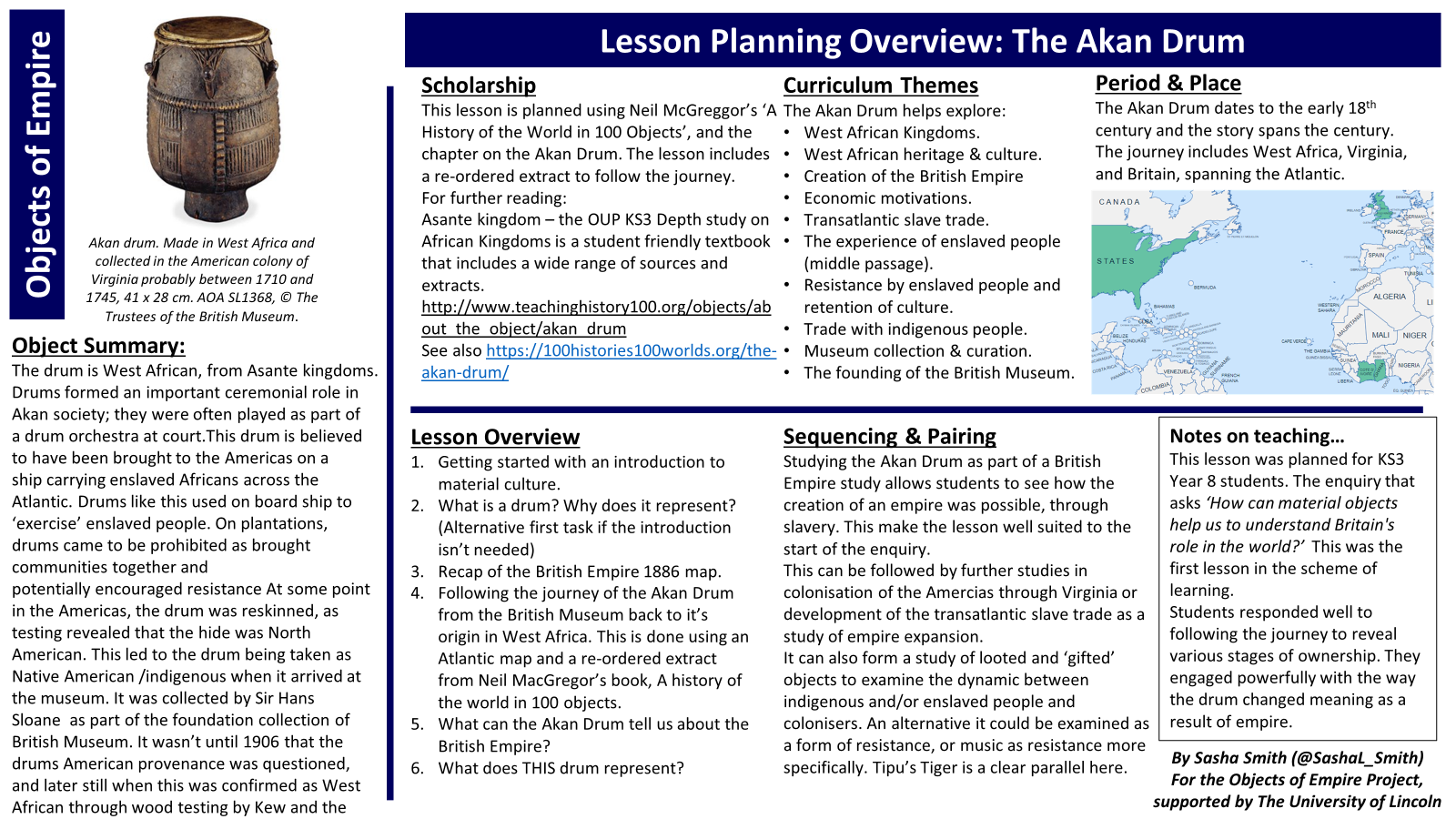Getting started with material culture
This lecture by Sarah on ‘Teaching with Things: History through Material culture’ was given for the Be Bold History network in January 2022, and discusses some of the key reasons why material culture is a great tool for teaching history while its analysis provides numerous opportunities for developing historical skills. It was in response to this lecture that Sasha got in touch and the collaboration started.
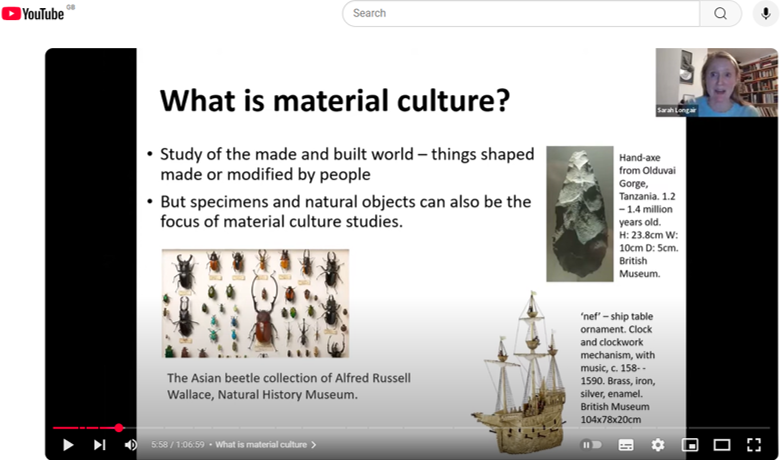
Ten reasons to use objects in your curriculum:
The following is a non-exhaustive list of reasons why incorporating objects enriches your curriculum. These can be used as a way to help sell object incorporation or an object-led enquiry to your department.
- Academic rigor – using material culture reflects the academic history community and what is happening in FE.
- Broadens historical knowledge – one object can allow for a visual access to a wealth of themes.
- Broadens historical skills – students become more adept at using source material and material culture, as well as understanding how historical narratives are built.
- Accessing complex histories – thematic pull of objects, and the ability to draw out those themes in a limited time.
- Accessing the history curriculum beyond text – we see this already with visual sources. Objects do this, and then some!
- Enquiry-based learning– enquiry questions can be focused on an object to allow for a clear focus.
- Storytelling – objects provide an ideal way to root students in a particular story from which they can build from an individual object to larger phenomena.
- Flexible – what you can do with an object will really vary depending on how you scaffold, and what you get from them can vary significantly.
- Bang for your buck – Objects allow you to explore a broad range of themes through one item, maximising your lesson time.
- Objects are brilliant – they are engaging, complex, and invite curiosity… not just for the students!
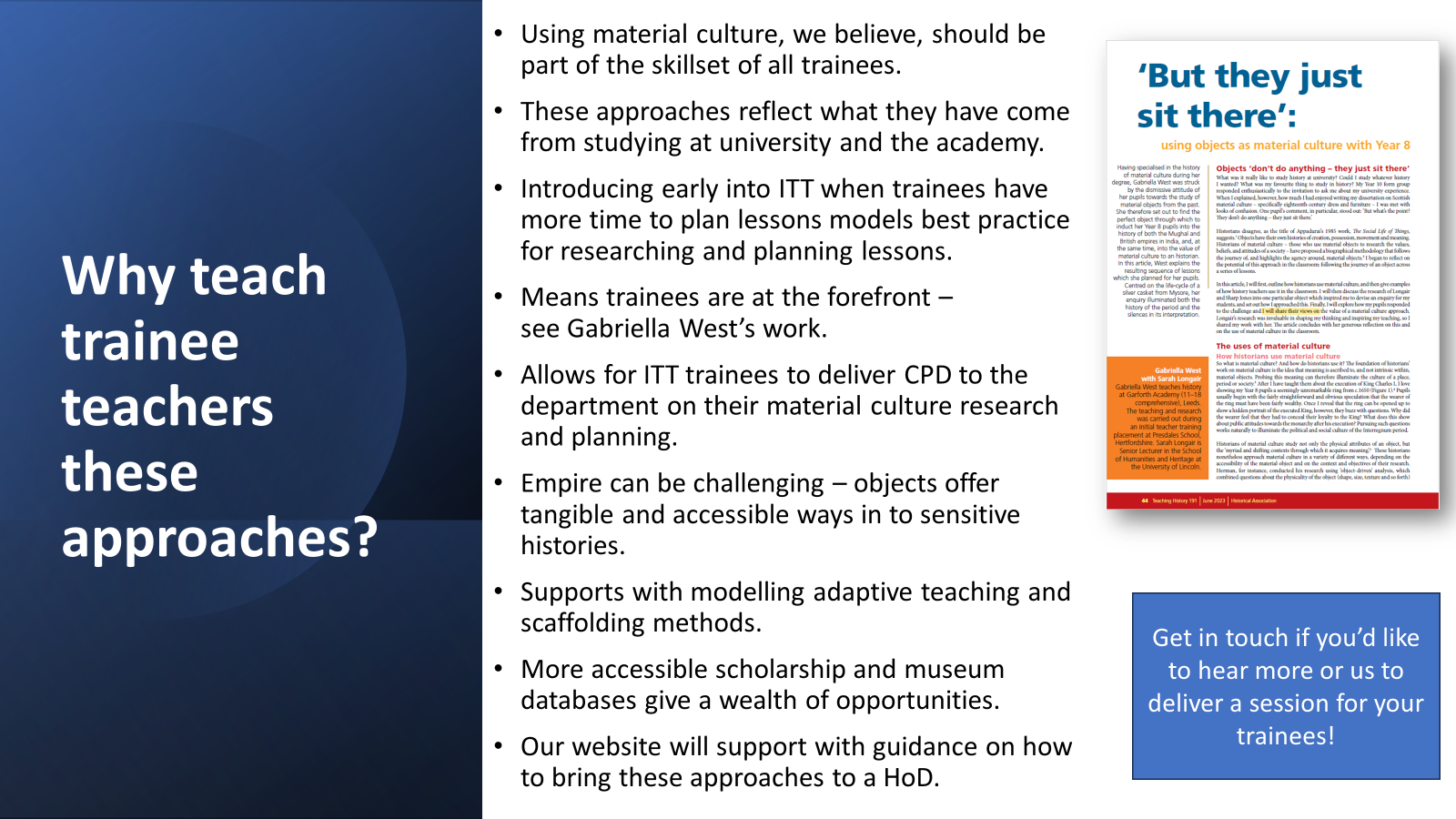
Where can I get started looking for objects?
As a result of colonial conquest, museums in Europe and North America have numerous objects which offer insights into the colonial era. Museums across the world also have rich collections for exploring the theme of empire. Their databases, with images you can download and object descriptions, are useful starting points for researching material culture associated with empire. Local museums also have global collections and these can be particularly powerful to bring the reach of empire to your locality. While they may not have databases, it’s worth visiting and enquiring about this material.
- Victoria & Albert Museum,
- British Museum
- The Royal Collection
- Pitt Rivers Museum, Oxford
- Cambridge Museum of Archaeology and Anthropology
- National Museums Scotland
- National Army Museum
- Royal Museums Greenwich (for National Maritime Museum)
- National Museums Liverpool (for National Museum of Slavery)
- National Museum of African American History and Culture, Smithsonian, Washington DC
- Te Papa Tongarewa – Museum of New Zealand
- Iziko – Museums of South Africa
- National Museum Australia – link to colonial collections
- National Museums of Kenya
The 100 Histories of 100 Worlds project is an important resource for hearing previously excluded voices who have been empowered to tell their own histories about objects in the British Museum’s History of the World in 100 Objects.
For a starting point on how to research history and material culture, see also Sarah Longair and Leonie Hannan’s 2017 book History through Material Culture.
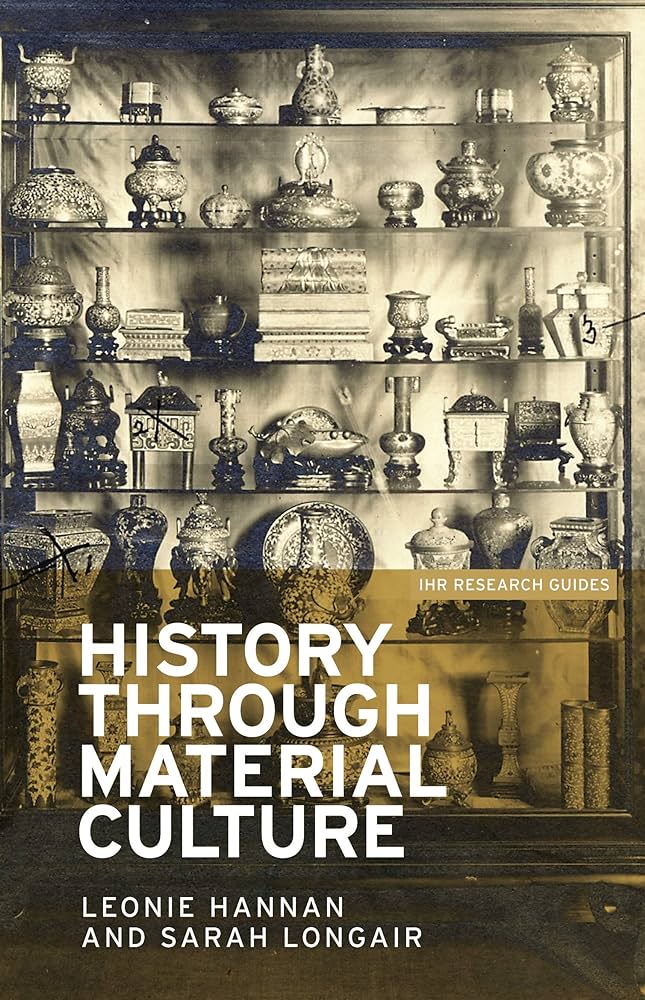
Building objects into your enquiry
When beginning to explore how to incorporate objects into your curriculum, consider:
Object use: How do you want to include objects?
Themes: What are the themes you want to include in your curriculum/enquiry?
Period/Place: Given the constraints of your curriculum time along with the breadth of empire, where and when do you your enquiry to focus?
Hinterland and wider curriculum: How will this enquiry continue threads of learning throughout your curriculum?
Setting: What are the important factors to consider when teaching empire to your students in your setting.
There is not right answer to these questions, each one will inform what might be the appropriate way to build a curriculum for your setting/students.
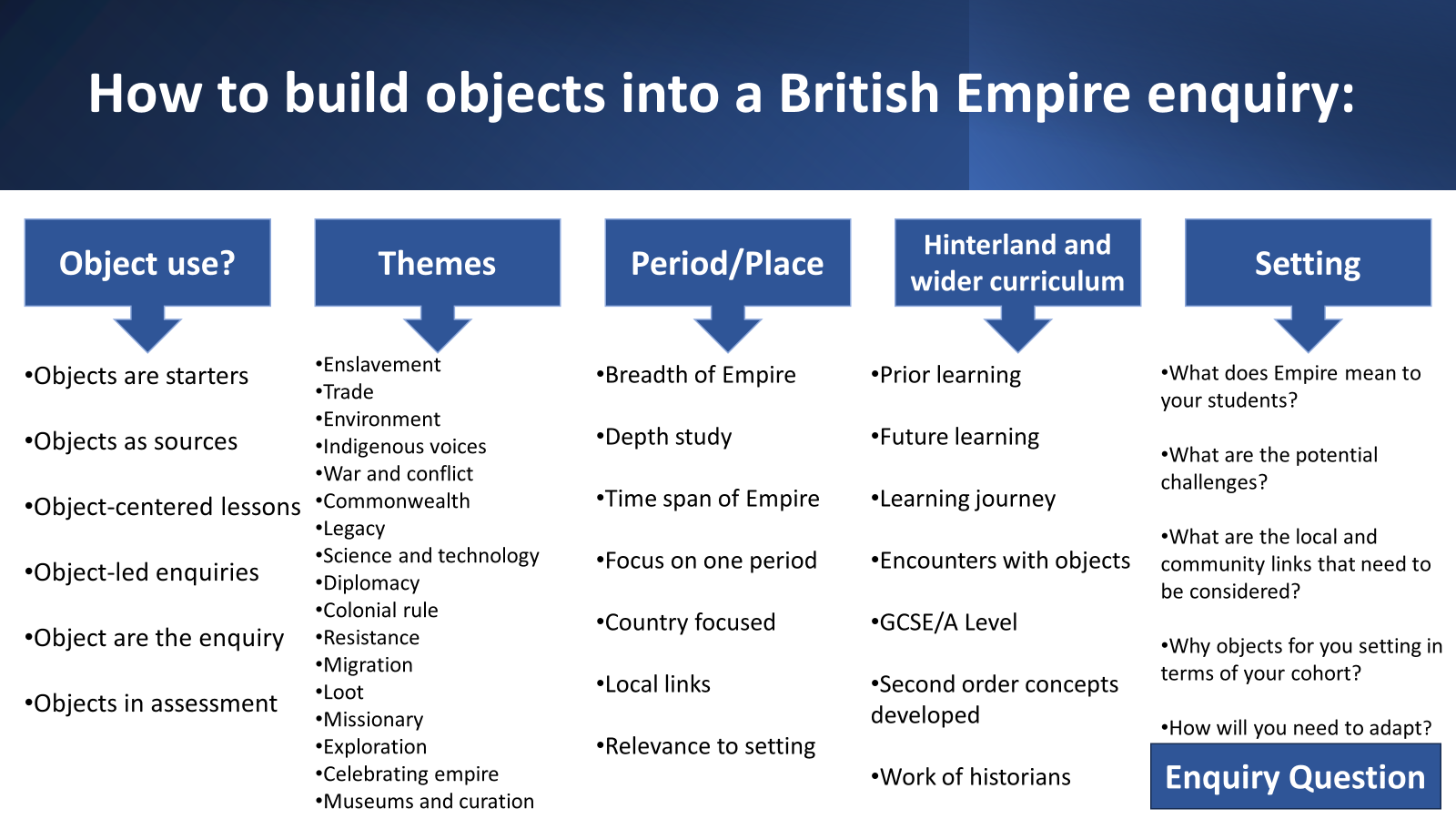
Investigating Objects
- In your own research of objects and your curriculum planning, it’s worth asking questions of the objects you are using to ensure you are using them to their full potential. What questions can we ask of objects to learn more about them?
- You can decide to focus more explicitly on some elements, but considering all of them helps to use all the possibilities that objects present to you and your students
- This can even turn into a classroom activity – enabling students to identify what they know, what they want to know and where they might find this out.

Classroom Ideas
Visual analysis and questioning: Asking students to examine the object, decide what they can determine from a visual analysis, and then preparing questions to understand the object within the context of the lesson, and/or enquiry.
Annotating an object: give a series of features to identify to help understand the object.
Context through other objects: Share one or two additional objects to contextualise the first, or a series of objects that speak to a particular theme or narrative.
Storytelling: Objects can be used as the story itself, exploring a period or place through the object. Objects can also be used alongside a narrative story to provide a powerful and engaging visualisation to make the period more tangible.
Trace the journey of an object: Object biographies can be used to explore who objects belonged to and how empire shaped their journey.
Historians’ research process: Objects can be used to explore the historians’ process, tracing how an object might be explored further with textual sources, scholarship, etc.
Textual primary sources: Using textual sources alongside objects can be used to show the relationship between the two, providing context and enriching source analysis.
Textual secondary sources/interpretations: Exploring how objects have been used by historians and how the object supports understanding of the period/place.
Writing object labels: Give students a word limit and ask them to write a label for a museum – what is important, what do you want the viewer to know, what voices can you include?
Designing small displays: Ask students to research/select objects from a number you have chosen to put together and then reflect: how and why did you make this decision? What story are you trying to emphasise?
Creating a museum exhibition: Ask students to curate a collection of objects that when placed together provide a narrative of a period, place, or people. This can then be developed by asking students to consider exhibition displays to set the tone of an exhibition, or creating educational resources to sit alongside the exhibition.

Objects of Empire – The Lesson Planning Overview
Each object has a ‘lesson planning overview’ one page slide. This follows our guideline for how to incorporate objects by offering:
- Object summary: a potted history of the object and its story.
- Digital image: with reference to where the image is taken from to encourage proper referencing of objects and so you can refer to where museum collection the object has come from.
- Scholarship: All objects overviews and lessons are underpinned by scholarship about the object and/or the period in question. There are links/reference to the scholarship, along with further reading and suggestions.
- Curriculum Themes: This is list of the key themes the object helps to explore to help you begin to consider where and how this may fit for your curriculum.
- Period and Place: This is listed and illustrated to support with building a sense of period and place within your curriculum.
- Lesson: This will either be a lesson sequence or lesson ideas for ways that the object could be incorporated into your curriculum at lesson level. We’re always keen to hear more!
- Pairing and Sequencing: Here we examine ways the object can be paired with others and sequenced with other empire themes. These mix examples of how the object has already been used by teachers, along with suggestions for how it could be used in other ways.
- Notes on teaching: This provides an opportunity for teachers to reflect on how the object was used and what students in their setting were able to draw from the object.
Featured example: The Akan Drum, The British Museum.
